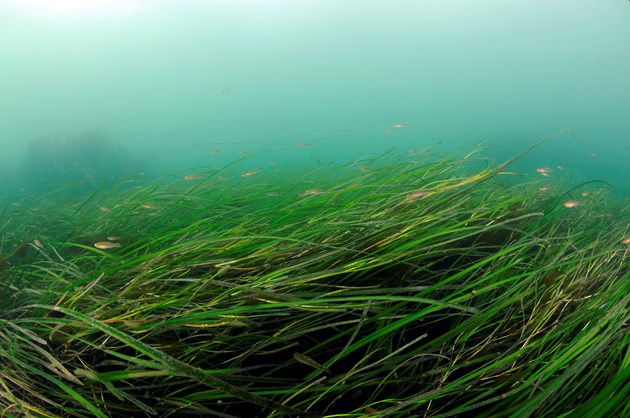Boosting Scotland's Coastline: Seagrass Restoration Bids

Table of Contents
The Importance of Seagrass Meadows in Scotland
Seagrass meadows are often called the "lungs of the sea," and for good reason. These underwater flowering plants provide a multitude of ecosystem services, playing a crucial role in the health and prosperity of Scotland's coastal environment. Their importance extends far beyond their beauty; they are vital for:
-
Significant carbon sequestration potential (blue carbon): Seagrasses are incredibly efficient at capturing and storing atmospheric carbon dioxide, playing a vital role in mitigating climate change. They are far more effective at carbon sequestration than terrestrial forests.
-
Coastal erosion protection and stabilization: The dense root systems of seagrass meadows bind sediment, reducing coastal erosion and protecting shorelines from storm damage. This natural coastal defense is invaluable in protecting coastal communities and infrastructure.
-
Habitat for a wide range of species, supporting fisheries: Seagrass meadows provide crucial nursery and feeding grounds for numerous commercially important fish species, as well as invertebrates and other marine life, contributing significantly to Scotland's fishing industry.
-
Improved water quality: Seagrasses filter pollutants from the water column, improving water clarity and overall water quality. This benefits both marine life and human activities dependent on clean water.
-
Contribution to Scotland's biodiversity: Seagrass meadows are biodiversity hotspots, supporting a rich array of plant and animal life, contributing significantly to the overall biodiversity of Scotland's marine environment.
Scientific studies, such as those published by the Marine Conservation Society and the Scottish Association for Marine Science, consistently highlight the ecological and economic importance of seagrass meadows, emphasizing the urgent need for conservation and restoration efforts.
Understanding the Seagrass Restoration Bid Process
Securing funding for seagrass restoration projects in Scotland requires a well-structured and compelling bid. The process typically involves several key steps:
-
Identifying funding bodies: A crucial first step is researching and identifying potential funding sources. This may include government grants (e.g., through NatureScot, the Scottish Government's environment agency), European Union funding opportunities, and environmental charities such as the WWF Scotland and The Wildlife Trusts.
-
Developing a strong project proposal: This requires a detailed and comprehensive proposal outlining the project's goals, methodology, feasibility studies, budget, timeline, and expected outcomes. A strong proposal demonstrates a clear understanding of the project's environmental and socio-economic impacts.
-
Conducting environmental impact assessments: Before commencing any restoration work, a thorough environmental impact assessment must be carried out to ensure that the project minimizes any potential negative consequences on the surrounding environment.
-
Community engagement and stakeholder consultation: Engaging with local communities, fishermen, and other stakeholders is crucial to ensure the project's success and build support for the initiative. Collaboration fosters trust and ensures that the project aligns with community needs and values.
-
Monitoring and evaluation of project outcomes: Regular monitoring and evaluation are essential to track the progress of the restoration project, measure its success, and identify any areas for improvement.
Websites such as the NatureScot website and the Scottish Government website provide valuable information on grant applications and funding opportunities for environmental projects. Successful bid examples can often be found through these channels, offering valuable insights into successful applications.
Successful Seagrass Restoration Projects in Scotland
Several successful seagrass restoration projects in Scotland showcase the effectiveness of various restoration techniques. These projects provide valuable lessons learned and best practices that can inform future initiatives. Examples may include:
-
Project location and scale: Highlighting both large-scale and smaller, localized projects will demonstrate the versatility of approaches. Location details, including specific coastal areas, are important for geographically targeting information.
-
Restoration methods used (e.g., seed planting, transplantation): Explaining the different approaches and their suitability for different sites and conditions will highlight the complexity and nuance of seagrass restoration.
-
Monitoring techniques employed to assess success: Mentioning specific monitoring methods and their importance in evaluating the effectiveness of the restoration project.
-
Lessons learned and best practices: Drawing conclusions from past projects to improve future bids and execution. This could include adapting techniques, improving community involvement, or refining monitoring strategies.
Including images and videos of successful projects will make the article more engaging and easier to understand. Links to project reports and case studies will provide further detail for interested readers.
How to Get Involved in Seagrass Restoration Bids
Many opportunities exist for individuals, communities, and organizations to participate in seagrass restoration efforts:
-
Volunteering for restoration projects: Many organizations rely on volunteers to assist with fieldwork, such as planting seagrass seedlings or monitoring seagrass meadows.
-
Partnering with environmental organizations: Collaboration with organizations like the Marine Conservation Society or local environmental groups allows individuals to contribute expertise and resources to seagrass restoration projects.
-
Participating in citizen science initiatives: Citizen science projects offer opportunities for members of the public to contribute valuable data to seagrass monitoring and research efforts.
-
Supporting funding applications through advocacy: Advocating for seagrass conservation and restoration through letters to elected officials or public awareness campaigns can help secure funding for crucial projects.
-
Raising awareness about the importance of seagrass: Educating others about the vital role seagrass plays in our environment can inspire further action and support for seagrass restoration initiatives.
Websites of environmental organizations will often list volunteer opportunities and details on how to get involved.
Conclusion
Seagrass restoration bids are crucial for the revitalization of Scotland's coastal ecosystems. The process involves identifying funding bodies, creating strong project proposals, engaging communities, and continuously monitoring progress. By understanding the importance of seagrass meadows and participating actively in restoration projects, we can collectively protect and restore this vital habitat. Learn more about seagrass restoration opportunities in Scotland, explore potential funding sources, and consider volunteering your time, expertise, or donating to relevant charities. Let's work together to boost Scotland's coastline through effective seagrass restoration bids.

Featured Posts
-
 One Last Fight Ufc Legend Returns After A Year Away
May 04, 2025
One Last Fight Ufc Legend Returns After A Year Away
May 04, 2025 -
 Blake Lively And Anna Kendrick Feud A Complete Explanation
May 04, 2025
Blake Lively And Anna Kendrick Feud A Complete Explanation
May 04, 2025 -
 Man Sentenced To 53 Years For Hate Crime Attack On Palestinian American Family
May 04, 2025
Man Sentenced To 53 Years For Hate Crime Attack On Palestinian American Family
May 04, 2025 -
 Nervous Childs Bgt Exit Live Performance Interrupted
May 04, 2025
Nervous Childs Bgt Exit Live Performance Interrupted
May 04, 2025 -
 Angelinas Striking Resemblance To Bianca Censori New Photos
May 04, 2025
Angelinas Striking Resemblance To Bianca Censori New Photos
May 04, 2025
